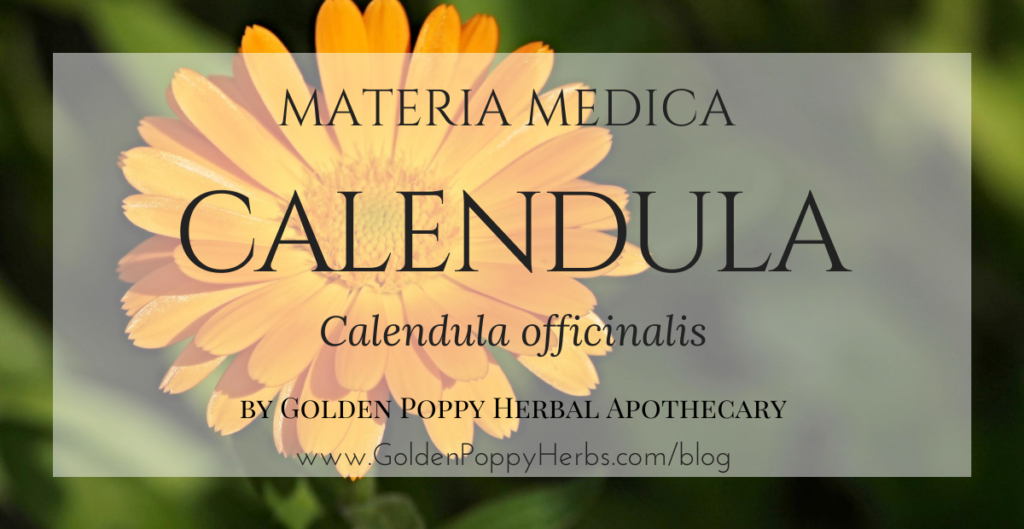CALENDULA IS ONE OF OUR VERY FAVORITE PLANTS. A GENERAL PANACEA HERB, WE USE IT IN ALMOST ALL OF OUR BODY CARE PRODUCTS FROM HEALING SALVES, TO BODY OILS, AND HAND CREAMS. WHENEVER WE THINK OF THE SKIN, WE THINK OF CALENDULA...
To many herbalists, calendula is a plant of abundance. In Colorado calendula has been known to bloom from early summer all the way through November, with each plant producing more blooms than we can count. The first year we planted 10 calendula plants, by the next season we had over 50...it never stops giving. Each day (ok, more like once a week) our herbalist would wander into her garden and spend 30 minutes or so picking every calendula flower head she could reach, and by the next day there would be an equal amount to the number she picked the day before, almost as if she hadn’t taken anything from the plants at all. Calendula is a happy, bright, and sun-loving flower, one that makes it impossible not to love. Coupled with the fact that the best time to harvest calendula flowers is when the sun is highest in the sky, it will get you out into the sunshine and undoubtedly make your day better. Calendula’s magical properties come in handy in a variety of situations. It is a mild alterative, which means it is beneficial for cleansing the system. It is also excellent for any type of skin condition, both to be used internally and externally. Because most skin issues are a result of the body’s detoxification process being ‘stuck’, taking calendula in tea can help move the lymph and push toxins from the body. Externally calendula can soothe inflammation, is mildly anti-microbial and can help kill off bacteria, and it gently stimulates new skin tissue to form. The best part is that it is also very gentle in all of these actions, which makes it an herb that is safe for almost anyone to use; from babies to grandparents. We put calendula infused oil into almost every single one of our products that goes onto the skin because we have seen first hand it’s amazing ability to improve the skin. You can also find calendula in several of our pre-made tea blends because we love it that much.
MATERIA MEDICA: CALENDULA
Latin Name: Calendula officinalis Common Names: Calendula, Pot Marigold TCM Name: Jin zhan ju Botanical Description: The flower heads of calendula are one to three inches across and have a central cluster of tubular flowers surrounded by several rows of ray florets (Foster, 1993). The stalk supports many branching stems and oblong medium green leaves from 3 to 6 inches long (Foster, 1993). The plant grows up to 24 inches tall Parts Used: Flowers harvested as they open in early summer, dried in the shade. Calendula blooms nearly continuously from spring through fall as long as you continuously pick the blossoms. Chemical Constituents: Flavonoids, triterpenes, saponins, volatile oil, salicylic acid, mucilage and resin (calendulin), mucilage, carotenes 
Preparation & Dosing:
- External applications: lotion, salve, or wash as needed
- Tincture: (Fresh Flowers 1:2, Dry Flowers 1:5, 70% alcohol) 5-30 drops, to 4X a day. Dilute with several parts of water for topical use
- Tea: 1 tablespoon for 8oz hot water, allow to steep for 30 minutes.
- antiseptic
- astringent
- vulnerary
- alterative
- Anti-inflammatory
- Antibacterial
- Immune Stimulant
- Anti-fungal
- Antiviral
- Cholagogue
- Diaphoretic
- Lymphatic
- Antispasmodic
- Emmenagogue
- Cleanses wounds, reduces inflammation, promotes healing, stimulates circulation
- Good for almost any ‘accident’, minor cuts, scrapes, burns, acne, rashes, broken bones, considered a heal-all herb
- Also good for fungal infections such as athletes foot and thrush due to it’s anti-microbial properties
- Helpful for diaper rash and sore nipples from breastfeeding
- Can be combined with Vitamin E and rubbed on pregnant bellies to help prevent stretch marks
- Considered a cleansing herb, it can help with chronic skin problems such as acne and eczema
- Combines well with Plantain because it has similar actions and complimentary energetics
- Also helps with mild cases of stagnant liver
- Good for leaky gut, can help heal the lesions in the intestine
- Specific for congestion of the lymph in the creases of the pelvis
- Good for sitz baths or vaginal washes (not a douche!!) to cleanse the area
- Will help move the lymph through the body, promoting the removal of waste and illness
- Do not use calendula oil on wounds that are infected and oozing pus or you could risk sealing in the infection
- A member of the Asteracaea family, it could cause reactions in those sensitive to the plant family
- Should not be used in pregnancy
- American Botanical Council, 2000. Excerpt from Herbal Medicine: Expanded Commission E Monographs. Retrieved on September 30, 2014 from http://cms.herbalgram.org/expandedE/Calendulaflower.html.
- Bennett, Robin Rose. (2014). The Gift of Healing Herbs. Berkeley, CA: North Atlantic Books.
- Blankenspoor, Juliet (2012). Calendula – Sunshine Incarnate – an Edible and Medicinal Flower. Retrieved on September 29, 2014 from http://blog.chestnutherbs.com/calendula-sunshine-incarnate-an-edible-and-medicinal-flower.
- Culpeper, Nicholas (1653). The Complete Herbal. Bibliomania. Retrieved September 2014 from http://www.bibliomania.com/2/1/66/113/21123/1/frameset.html.
- Edwards, Gail Faith. (2000) Opening Our Wild Hearts to the Healing Herbs. Woodstock, NY: Ash Tree Publishing.
- Foster, Steven. (1993) Herbal Renaissance. Layton, UT: Peregrine Smith Books
- Hoffman, David. (2003) Medical Herbalism. Rochester, VT: Healing Arts Press.
- McIntyre, Anne. (1996) Flower Power. New York, NY: Henry Holt and Company, Inc.
- Panahi Y, Sharif MR, et al. (2012). A randomized comparative trial on the therapeutic efficacy of topical aloe vera and Calendula officinalis on diaper dermatitis in children. ScientificWorldJournal. 2012;2012:810234.
- Stubbe, CE and Valero, M (2013). Complementary strategies for the management of radiation therapy side effects. J Adv Pract Oncol. 2013 Jul;4(4):219-31.




